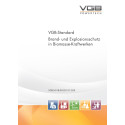Biomass plants are operated as heating, power and combined heat and power plants. Their fundamental difference from fossil fired power plants is the nature of the fuel. This also entails certain special features with regard to fire protection. In principle, VGB Guideline R 108 also applies to power plants of this type, but the specific characteristics of the biomass require a number of additions to that guideline. This standard therefore serves the purpose of making the experience of the recent past available to all VGB members and the interested public.
There have already been several fires in biomass power plants. In most cases, however, the circumspect behaviour of the highly qualified operating teams allowed the fires to be detected and combatted as they were arising. There was therefore mostly no major damage to the plants which could have disrupted operation in the long term or caused harm to the environment.
As a result of the high incidence of dust in the processing and transport of biomass and the specific properties of the dust created, it is fundamentally to be assumed that potentially explosive atmospheres may form.
This VGB-Standard presents methods of using operational and adapted technical measures to keep the risks of fire and explosion as low as possible. In this way, potential hazards can be avoided by the deployment of suitable operational workflows. Fires can be detected without delay and combatted effectively under the special conditions of the type of plant concerned. The formation of potentially explosive atmospheres can be limited by operational and technical measures.






